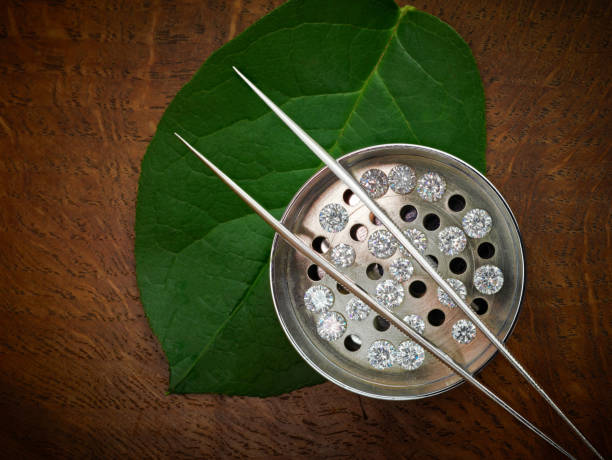Diamonds used to form over millions of years. These precious gems can now be created in a matter of weeks, thanks to advances in technology. They're known as lab-grown diamonds, and when used in engagement rings, they're just as bright, sparkling, and eye-catching as naturally found diamonds.
A lab-grown or lab-created diamond is one that has been grown in a controlled laboratory environment using processes that mimic the Earth's natural high heat and high pressure conditions. Lab-grown diamonds are very similar to natural diamonds in appearance and can be fully formed in a matter of weeks rather than millions of years.
In almost every way, lab-grown diamonds are identical to natural diamonds. They have the same chemical, physical, and optical properties as diamonds mined on Earth.
Lab diamonds are conflict-free and ethically sound due to how they are created. With increased awareness of the violence and human rights violations that occur in some diamond mines, many conscientious couples are looking for alternatives to traditional diamonds, which is how they come across lab-grown diamonds. Furthermore, lab-grown diamonds are typically eco-friendly, and certain cutters ensure that they produce carbon-neutral diamonds.

There are numerous other reasons why people prefer lab-grown diamond engagement rings. They are frequently excited to be able to obtain a diamond that is larger in size or of higher quality than they would have been able to obtain with a natural diamond. People can now size up to a larger carat for their desired shape. At the same time, people who buy lab diamonds tend to have more modern tastes when it comes to ring settings. This can include styles such as the hidden halo, contemporary twist designs, and rings with sleek metal.
Many couples appreciate the technological advancement in producing a lab-grown diamond, as well as its uniqueness in comparison to a traditional natural diamond. The thrill of being a part of something new and revolutionary is something a couple can share.
There's no denying that lab-grown diamonds are appealing, but there are still reasons why people prefer traditional, naturally-found diamonds. Shah emphasizes that lab-grown diamonds lack the "emotional" component of natural diamonds; natural diamonds take millions of years to produce, whereas lab-grown diamonds are created in less than ten weeks. Furthermore, because lab-grown diamonds are a relatively new market, the long-term resale value is unknown. These man-made diamonds may also be perceived as non-traditional, which may be a major issue for brides who prefer tradition.
Natural diamonds form in the Earth's crust, whereas lab-grown diamonds are created artificially. Lab diamonds have been around for over 20 years, but only in the last five to seven years have they become jewelry grade. They are now comparable to natural diamonds. Lab-grown diamonds are now available in a variety of colors, including yellow and pink, which are extremely rare in their natural states. High-quality lab diamonds are grown from seeds in conditions that use the purest form of carbon, Type IIA. Lab-grown diamonds are graded using the same cut, color, and clarity criteria as natural diamonds. They also go through the same certification processes as natural diamonds.
The only real distinction is in their construction. There would be no way to tell a natural diamond from a lab-grown diamond if they were placed side by side. This is why it is critical to buy a certified diamond to ensure that it has been vetted for quality.
We've seen a shift from 100% natural to about 50% of customers ordering lab diamond since January [2020]. According to a 2019 Bain report, the lab diamond market grew by 15 to 20% last year alone. We believe it will be higher this year. It has been refined over the last five years to the point where lab-grown diamonds and natural diamonds cannot be distinguished. As with any technology-focused industry, there will undoubtedly be more efficiencies and controlled processes in the future that could speed up the rate at which diamonds are grown while also providing greater control over diamond quality. However, only time will tell how quickly these advances can be made.
Some common misconceptions and myths about lab-grown diamonds have persisted since their discovery. Some people believe they will appear different, but they do not. People believe they are "fake," but they are not. They are the exact same composition as a naturally discovered diamond.
Some people mistakenly believe they are worthless. Despite the fact that they are manufactured, they are diamonds and have value.
Natural diamond supply chains can be complex, and logistical costs can add up, making natural diamonds more expensive than lab-grown diamonds. The most amazing thing about lab-grown diamonds is that they can cost up to 30% less than natural diamonds.
Not every jeweler carries lab diamond rings. If you have your heart set on a lab-grown diamond, check to see if the store sells them before going to try on rings. These diamond rings are distinct from the centuries-old tradition of marrying with an Earth-mined diamond. Because lab-grown diamonds are sold by newer retailers, ring designs are often more modern, contemporary, and fresh when compared to traditional retailers who only sell natural diamonds. It's no surprise that they're becoming increasingly popular among young couples looking to marry.
You should clean your lab-grown diamond ring on a regular basis, just like you would a traditional ring. Depending on the style of your ring, you should definitely consider regular maintenance to check for loose stones and prong wear.
Sell your diamonds with ease with Diamond Registry’s comprehensive approach and vast global industry connections to help you find the best buyer for your diamond fast. Visit www.diamondregistry.com/sell-your-ring to take your first step to fast, easy and reliable way of selling your diamond.
Want to check and calculate diamond per carat instantly? Go to DR’s diamond price calculator to know how. Reliable and trusted carat calculator in the diamond industry since!

